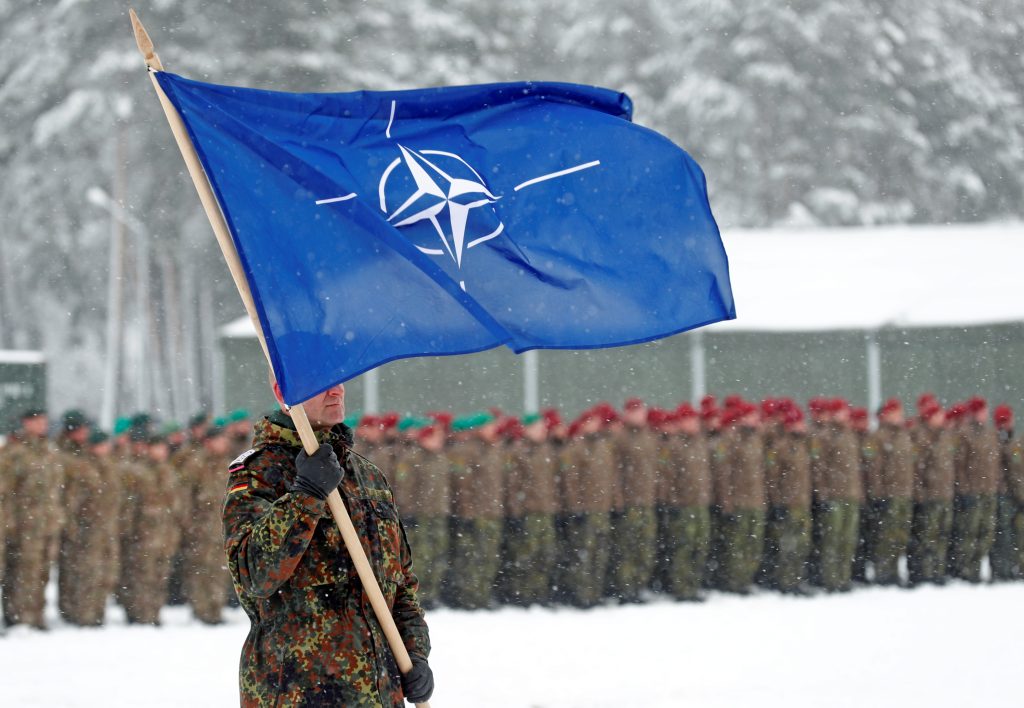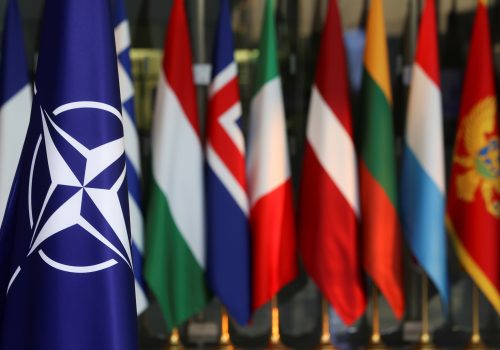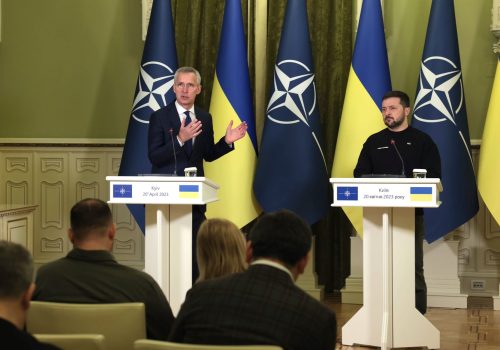For the past nine years, NATO has followed a defense spending guideline seeking member expenditures at 2 percent of gross domestic product (GDP) and equipment spending at 20 percent of defense spending by calendar year 2024. What came to be known as the “2/20” guideline was issued at NATO’s Wales Summit in September 2014, shortly after Russia’s annexation of Crimea in March of that year. The summit declaration explained the renewed focus on capabilities: “Russia’s aggressive actions against Ukraine have fundamentally challenged our vision of a Europe whole, free, and at peace.”
With Russia’s war on Ukraine still raging in Europe, and with NATO due to celebrate its seventy-fifth anniversary in conjunction with the 2024 Washington Summit, now is the time to reassess the efficacy of NATO’s “2/20” guideline. NATO needs a policy planning benchmark that effectively addresses the scope and pace of the military conflict impacting Europe and the likely security environment it will face in the years to come. One such benchmark could be flexible targets for real growth of defense spending.
Looking to real growth in defense spending
NATO Secretary General Jens Stoltenberg has previously underscored that the 2 percent of GDP metric should be looked at as a “floor” and not a “ceiling” for allied defense planning. Yet the most recent NATO defense spending data released in July 2023 indicate that the 2 percent goal has not been universally achieved, and the “2/20” goal itself is only partially successful. Two important points are worth highlighting in the July report.
First, significant progress has been made on the defense equipment front. NATO itself achieved the 20 percent guideline for equipment expenditures, with a median equipment expenditure of 27.80 percent. All current NATO members are estimated as having met the equipment spending guideline in 2023.
Second, the median NATO defense expenditure is estimated for this year at 1.82 percent of GDP. Eleven countries, many on the eastern flank with Russia, have met their 2 percent commitment. This was accomplished by these members regularly providing annual real growth to their defense programs beyond the rate of inflation.
If NATO’s 2 percent of GDP goal is to be viewed as a floor for member spending, then a defense real growth pathway should be the benchmark by which all NATO countries achieve this goal. Several countries are already quite close to 2 percent of GDP and could achieve it quickly with sustained spending on defense above the rate of inflation. Real defense growth need only exceed national economic growth for several years, until the 2 percent threshold is met. Once a country achieves the 2 percent “floor,” to stay there, it should continue increasing its defense spending at a rate commensurate with its annual national economic growth. A reasonable transition period for the remaining NATO members now below the 2 percent goal would be two or three years, especially if inflation rates continue to fall in Europe as projected.
NATO’s lesson from the 1970s
NATO leaders can draw a lesson from the 1970s to inform this resource strategy. By the late 1970s, NATO began advancing robust defense policies as it came to understand the extent of the Soviet military buildup. At its 1977 Defense Ministerial, NATO openly acknowledged this problem and committed to a 3 percent real growth goal for defense spending. The 1977 NATO Defense Ministerial communiqué made the case for changing NATO’s policy course, arguing:
“ . . . an annual increase in real terms in defence budgets should be aimed at by all member countries. This annual increase should be in the region of 3 percent, recognising that for some individual countries: economic circumstances will affect what can be achieved; present force contributions may justify a higher level of increase.”
The 1977 NATO policy was realistic, flexible, and balanced. In advancing annual increases “in the region of 3 percent,” it anticipated different members’ macroeconomic conditions, unique member defense requirements, and the impact of inflation, a major concern then as it is now. A similar policy is needed today to encourage adequate defense spending by all allies. NATO could follow the example of 1977 with a flexible 3 percent real growth goal, or Alliance members could instead agree on a target slightly above or below that number. A consensus guideline and the expectations it establishes are just as important, or perhaps even more so, than the exact figure.
Resourcing NATO’s Strategic Concept and Force Model
NATO’s Strategic Concept, released at the Madrid Summit in 2022, underscored the demands of the new strategic environment now facing allies. With the Strategic Concept, NATO committed to strengthening Alliance defense capabilities across a balanced defense posture in all five domains: air, land, sea, cyber, and space.
Moreover, NATO’s new Force Model provides for “…an Allied response at much greater scale and at a higher readiness than the current NATO Response Force, which it will replace.” The new Force Model provides for a three-tiered approach to force generation, with tier one requiring 100,000 forces within ten days, and tier two requiring 200,000 within thirty days. Additional capacity and readiness will be needed for “short-notice contingencies,” thus requiring greater resource commitments toward readiness.
Finally, member munitions production must rise for as long as Russia’s war on Ukraine continues. As Stoltenberg has explained in February of this year, “The war in Ukraine is consuming an enormous amount of munitions. The current rate of Ukraine’s ammunition expenditure is many times higher than our current production rates. This puts our defense industries under strain.”
NATO’s continued provision of arms and munitions to Ukraine requires increased weapons production so its members can replenish weapons inventories drawn down by the transfers to Kyiv. This will necessitate higher defense procurement spending for the duration of the war and beyond.
In all, a new defense resource pathway is needed to accelerate defense investment that services NATO’s Strategic Concept and Force Model. For NATO to modernize across all missions and domains and for allies to continue their support for Ukraine, the Alliance as a whole needs to spend more on defense. To spend more on defense, it needs guidelines to encourage not just a goal of more than 2 percent of GDP per year, but also a guideline for countries short of that goal to reach it. The force modernization that NATO requires and has been insisting upon can be best achieved through an Alliance-wide commitment to real growth in defense spending.
The NATO Summit in Washington in 2024 is a golden opportunity for the Alliance to endorse a defense real growth pathway to its “2/20” guideline. But to achieve this by the summit, negotiations need to start now.
Wayne A. Schroeder is a nonresident senior fellow with the Transatlantic Security Initiative in the Scowcroft Center for Strategy and Security at the Atlantic Council.
Further reading
Mon, Jul 10, 2023
We don’t really know which NATO allies are pulling their weight. Here’s how to fix that.
Issue Brief By John R. Deni
As NATO allies gather in Vilnius, there will be much discussion about burden-sharing and who's living up to the 2014 Defense Investment Pledge. But exclusive statistical analysis by John R. Deni shows that spending more on defense doesn't necessarily add up to contributing more to NATO missions.
Tue, May 23, 2023
Providing long-term security for Ukraine: NATO membership and other security options
Issue Brief By Hans Binnendijk, Franklin D. Kramer
This issue brief evaluates membership and other security options for the alliance and its members to consider with regards to Ukraine, from formal actions by NATO as a whole to collective or individualized efforts by member nations.
Thu, Mar 16, 2023
The future of NATO C4ISR: Assessment and recommendations after Madrid
Report By
Current C4ISR capabilities, concepts, policies, and processes do not meet all of the Alliance’s needs. While much has been done to improve NATO C4ISR over the past decade, much work remains.
Image: A soldier carries the NATO flag during German Minister of Defence Ursula von der Leyen's visit to German troops deployed as part of NATO enhanced Forward Presence (eFP) battle group in Rukla military base, Lithuania February 4, 2019. REUTERS/Ints Kalnins



